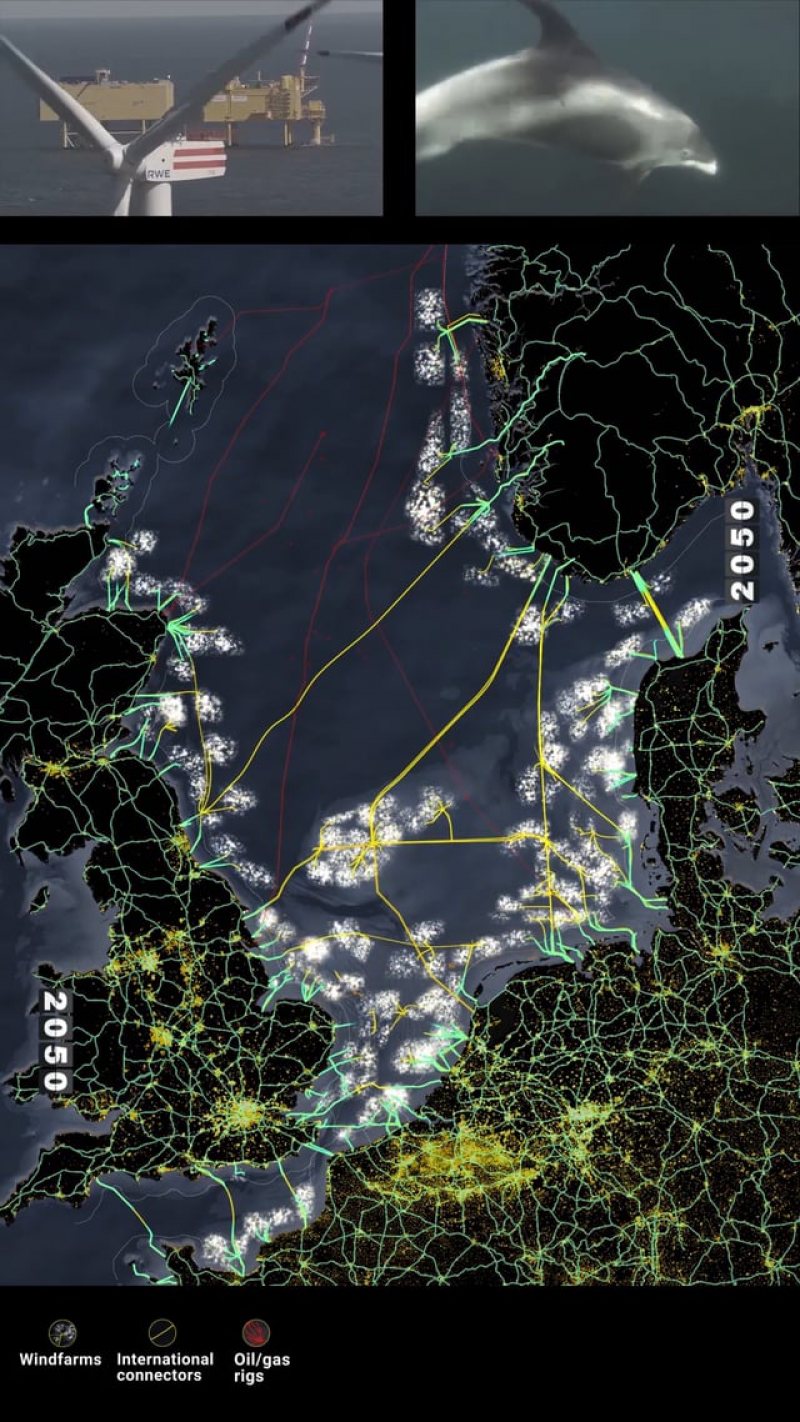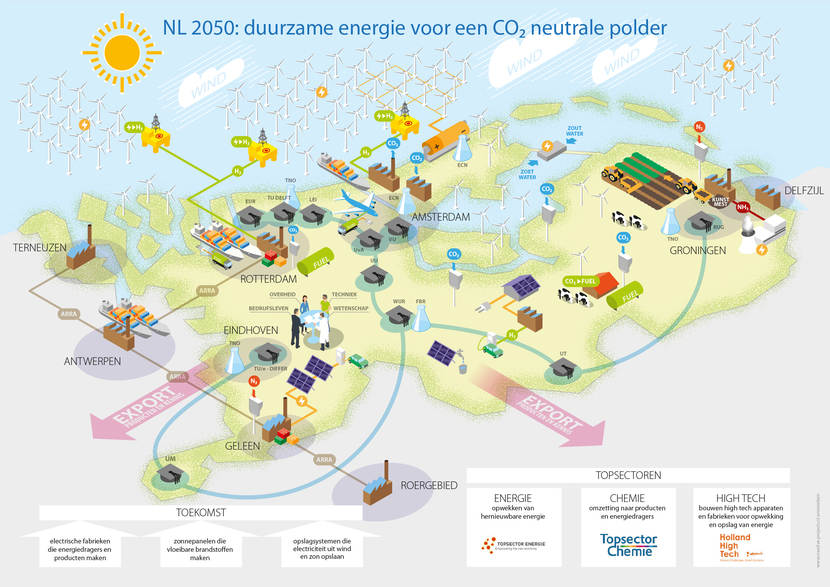Concepts of Energy Systems for 2050
2019 Stategie Plattform: Power to Gas "Startseite"Het team EnergyNL2050 heeft het eindraport "The future Dutch Full carbon-free Energy System" op 6 maart 2018 uitgebracht met de volgende samenvatting:
The Dutch energy system will look quite different in 2050 from what we have today. It is very important to have a detailed view on the expected 2050 system so that an efficient transition can be defined and realized.
Many published scenarios still make use of a considerable amount of carbon fuels in 2050 which makes it difficult to arrive at the desired CO2 emission targets. It is often claimed that this cannot be achieved without the (extensive) use of CSS technology.
We have set as our goal to have a zero carbon energy system and investigate if the Netherlands can satisfy the demand largely by energy resources from the Netherlands. This design study shows that this is indeed possible. However it will necessitate big changes in how we use energy at the demand side and how we match the demand with the available energy supply. The proposed design has not been simulated but seems feasible. Nevertheless it is suggested to perform simulations in order to validate the design.
De inhoud van de onderstaande nieuwsitems en artikelen zijn mogelijke bouwstenen voor de afweging om te komen tot kansrijke energie transitie mogelijkheden voor de verduurzaming van de energiesystemenn in Nederland. Deze items zullen op hun merites worden beschouwd en worden uitgewerkt door het KIVI Energy Expert Team, daarna worden opgenomen in het programma EnergyNL2050. Hiervoor wordt intensief overlegd met vele ter zake kundige experts voor kennis en het ondersteunen in de uitwerking. Het Team EnergyNL2050 pretendeert niet volledig te zijn, ex aanvullingen en reacties zijn dan ook welkom.
Energy Now
The congresses Energy Now in 2017 and 2016 directly related to the current energy transition.
The occasion to join and to discuss, also to bring in a lot of new ideas.
The goal was to inspire, interest, and trigger students to take elegant action in the transition towards sustainable energy.
These events created a bright perspective on the energy transition by focusing on the opportunities it creates in the present rather than just on the distant future.
Promising innovations and developments in the field of energy were highlighted from different perspectives, as research, academics, companies and entrepreneurs.
The event creates the ability to strengthen the connection between students, business people and researchers.
The following documents are represented for the concepts of EnergyNL2050:
NERA
Het NERA heeft voor de route Energietransitie "Tien uitdagingen" samengesteld voor de energietransitie.
Energie-gerelateerde vragen waren in eerste instantie verdeeld over diverse routes in de wetenschapsagenda. Wim Sinke (ECN, AMOLF, UvA) namens het Nederlandse samenwerkingsverband voor energieonderzoek NERA en medetrekkers Kornelis Blok (TUD, Ecofys) en Richard van de Sanden (DIFFER, TU/e):
Wij hebben ervoor gepleit om voor de energietransitie een aparte route te maken, omdat het één van de grootste uitdagingen van deze eeuw is met technologische, maatschappelijke, economische, juridische en ruimtelijke uitdagingen. Het vraagt om excellente bouwstenen, een integrale aanpak en breed draagvlak.
NERA werd uitgenodigd om de route Energietransitie uit te werken en deed dat samen met meer dan 200 breed georiënteerde deskundigen uit het onderzoeksveld.
Een intensief proces van inventariseren, prioriteren, integreren en formuleren.

2050 – An Energetic Odyssey is an installation comprising a 12-minute animation that provides answers to the seemingly simple question: ‘If we take the two-degree climate target seriously, what should we do?’
The Odyssey focuses on the North Sea. The highlight of the plan are 25,000 10MW wind turbines that will be able to meet about 90 percent of the energy demand of the North Sea countries by 2050.
The animation is a meticulous visualization of a possible future: step by step, it takes the audience to 2050, explains what has to be done and what the underlying considerations are, and addresses energy saving and decentralized energy production and describes the impact on employment and on the ecology of the North Sea. The logistics of this mega operation are extensively discussed as well.
The collaborative production process, the presentations of interim results and the exhibition and debate during IABR–2016 have forged a consortium of actors in which offshore builders, a wind turbine manufacturer, ports and power companies, several Ministries, nature NGOs, marine ecologists, and designers have jointly reached the conclusion that yes, it can be done.
In the context of the Dutch EU Presidency, the Directors-General for Energy and subsequently the informal council of EU countries’ Energy Ministers have previewed the Odyssey. The Ministers not only watched the installation, but were also inspired: the press release following the regional partnership agreement of the North Sea countries that was established during the Dutch presidency states that ‘it helped that we could show our colleagues how the operation would work’.
2050–An Energetic Odyssey was produced by IABR in collaboration with the Dutch Ministry of Economic Affairs, Van Oord, Shell, TenneT, Zeeland Seaports, European Climate Foundation, Natuur & Milieu, RWE, Port of Rotterdam Authority and Port of Amsterdam. Concept: Maarten Hajer and Dirk Sijmons (lead designer) Research by design and animation by H+N+S Landscape Architects, Ecofys and Tungsten Pro. Hereby the link to the video's 2050 An Energetic Odyssey (short version): More information on the website of the IABR.
Themadag Elektrochemische Conversie & Materialen 16 juni 2017
De maatschappij staat aan de vooravond van een grote energie- en grondstoffentransitie voor de overgang naar een CO2-neutrale economie in 2050, de ambitie die het kabinet stelt in de Energieagenda. Dit is een grote uitdaging, met name voor de traditionele kapitaalintensieve sectoren, zoals de chemie, raffinage en staalsector. Om die transitie mogelijk te maken zijn innovaties nodig die het verschil maken, stelt ook VNO-NCW in zijn visie voor het kabinet, NL Next Level. De exponentiële toename van duurzame energie uit wind en zon biedt een aanzienlijke kans voor grootschalige verduurzaming.

